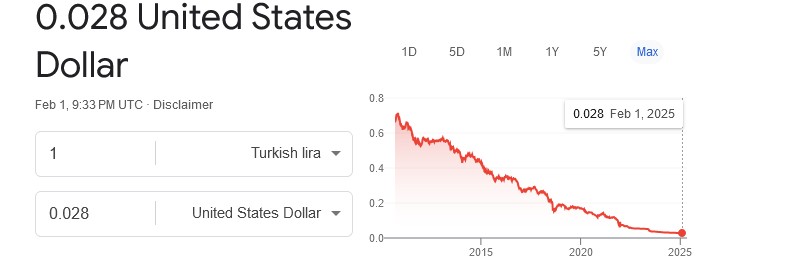|
Are Turkish Shotguns Junk, or Bargains?  The safest answer is “yes.” Firearms are extremely low-tech compared to automobiles, electronics, and so forth. There has been no significant advancements is the comparatively simple machining required in a shotgun over the last 30 years. Americans tend to like cheap things. The cost of manufacture n Turkey is ridiculously low, as the Turkish lira continues to plummet against the U.S. dollar. In 2010, the Turkish lira was worth 65 cents. In 2020, it was worth 17 cents, and today it is worth under 3 cents: 2.8 cents as of February 1, 2025. It is literally pennies on the dollar, It does not look to improve anytime soon, for as of January 17, 2025, Turkey's inflation rate was 44.40%.

It should come as no surprise that several “Italian” guns use Turkish parts. The Winchester SXP is made in Turkey, and Browning and Beretta heavily source parts from Turkey along with many other brands. Beretta has a plant in Turkey (Vursan, purchased in 2002) so they can source from themselves. Turkish guns still have a poor reputation. If guns were all the same price, no one would buy a Turkish gun as opposed to an Italian or German gun. The general
American consumer has voted loud and clear: the low initial
price generally wins. Camo dips win-- you can skip
polishing. Plastic stocks win: a few cents of melted beads
dropping out of a mold wins vs. costly walnut: selecting the
walnut, drying the walnut, machining the walnut, checkering
the walnut, and finishing the walnut. Cheap chokes, cheap
recoil pads, cheap fake wood finishes, cheap everything is
what is used to give most American consumers just exactly
what they demand-- cheap guns. Cheap and high quality does
not come in the same box. Warranties cost money, customer
service costs money, inventory of parts costs money,
advertising costs money, and insurance costs a whole lot of
money. In Turkey, there is no EPA, OSHA, and no CIP or SAAMI
standards, and zero independent proofing. One of the few
benefits of age is being able to experience trends first
hand. I wrote of the "Turkish Invasion" nineteen years ago:
https://chuckhawks.com/turkish_invasion.htm
. Most of the models mentioned in that article have ceased
to exist due to popular complaint. A large part of the problem is not Turkey: it is American brands that insist on importing the cheapest. Over the years, I've tested several Turkish models that were generally solid, but have failed due to poor American distribution and support. I'm referring to Girsan and “Impala Plus” inertia guns that had potential, but have failed to catch on. Bruno Civolani invented the internal inertia short recoil action, in production since the Benelli 121 of 1969. Benelli failed, rescued by Beretta Holding. In 1983, the Benelli Montefeltro was introduced: the same year Beretta acquired Benelli. Not much has changed in the last 42 years with that action. Now that the patents have long expired, there is a deluge of copy-cat Montefeltro action shotguns, mostly from Turkey, though Browning belatedly joined the group with their new A5. Benelli had the most notable failed model, the Benelli Vinci. Benelli, with their gimmicky models, high prices, and bogus claims has lost market share every year. That many of the models don't shoot straight in adding insult to injury. Retay of Turkey had potential, but they quickly added wildly fraudulent claims (over 20% more pellets on target”) and doubled their prices, a smarmy way to cheat customers. Sadly, no American shotgun manufacturer has gone the cheap to make inertia gun route in all these years, Small wonder the American shotgun industry has been vanishing. Eleven years ago I compared three 12 gauge inertia guns: https://chuckhawks.com/compared_inertia_shotguns.htm . Since then, Girsan has essentially vanished in the U.S, the Benelli Vinci crashed and burned into the Island of Misfit Toys, and only the Browning A5 remains. The Girsan MC312 was easily the best value of the three, yet the MC312 did not gain much traction in the United States. The Girsan never did make the jump to other gauges, nor did the Vinci before its discontinuation. In all these years, the basic Montefeltro action has changed very,very little: it has been copied and cloned to death. If a shotgun model has a poor trigger, it is only because it is not checked. If a shotgun does not shoot to point of aim, it is also because it is not checked prior to shipment. If a shotgun does not cycle with the loads it is claimed to work with, it is also because it is not checked. If a shotgun is extremely stiff-loading ('Benelli Thumb') it is again a lack of quality control or general incompetence, take your pick. If a shotgun does not come with choke tubes that perform as marked, yet again there is no quality control or it is just reckless incompetence, take your pick. In many cases, the 'bargain' shotgun isn't the bargain you hoped for after you pay for a trigger job, decent choke tubes, a reasonable recoil pad, and have had to replace mainsprings to get it to either stop rattling or cycle the loads it was supposed to. This reminds me of the old “spec guns” of years gone by from Western Auto, Sears, and Montgomery Wards “Western Field” and the like. No one actually accused Western Auto or Wards of designing or manufacturing firearms: it was just get quotes for pumps, single shots, bolt actions, or whatever from various sources. The lowest price normally wins, the best quality normally does not. That is part of the continuing problem, for American importers often seek the very lowest price, so that's exactly what Turkish companies are compelled to provide. There are a few durable, workhorse models that have already stood the test of time and have been running strongly for a decade by now, like the Weatherby Element series, refreshed as the “Element II” this year. In the future, there may well be more, but for now the Element (made by ATA to Weatherby specifications) is one of the precious few that has had staying power. |